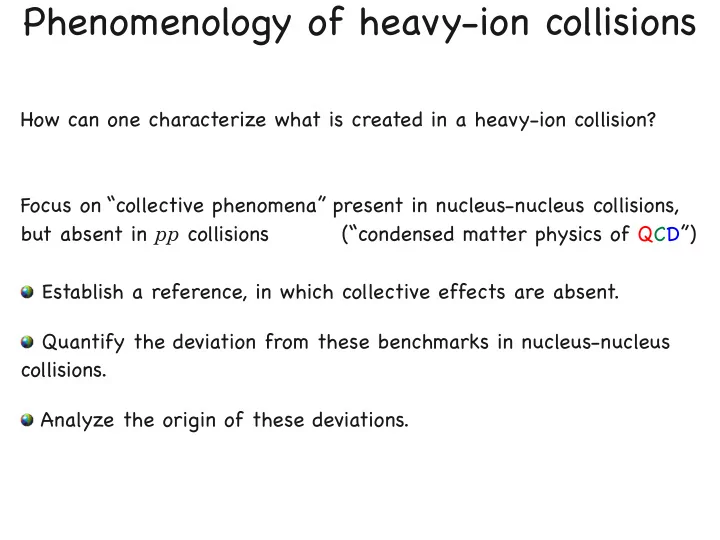

Phenomenology of heavy-ion collisions How can one characterize what is created in a heavy-ion collision? Focus on “collective phenomena” present in nucleus-nucleus collisions, but absent in pp collisions (“condensed matter physics of QCD”) Establish a reference, in which collective effects are absent. Quantify the deviation from these benchmarks in nucleus-nucleus collisions. Analyze the origin of these deviations.
First measurement: multiplicity number N ch of charged particles ∝ PHOBOS Collaboration, Phys. Rev. Lett. 85 (2000) 3100
First measurement: multiplicity number N ch of charged particles ∝ PHOBOS Collaboration, Phys. Rev. Lett. 85 (2000) 3100
Nucleon-nucleon cross-section taken from Miller, Reygers, Sanders & Steinberg, Ann. Rev. Nucl. Part. Sci. 57 (2007) 205
Multiplicity distribution Vary the equivalent number of nucleon-nucleon collisions between ¯ ¯ and : N AB N AB part ( b ) coll ( b ) � 1 − x � ¯ ¯ part ( b ) + x ¯ ¯ N AB N AB N AB ( b ) = coll ( b ) N NN 2 Probability P ( n , b ) to find a multiplicity n in a particular A-B collision at impact parameter b : ¯ Gaussian around , with some dispersion; N AB ( b ) given by a Monte-Carlo simulation. event-multiplicity distribution: d N evts � � � AB � 1 − σ inel � = d b P ( n, b ) 1 − NN T AB ( b ) d n probability that an inelastic process occur
Multiplicity distribution taken from Miller, Reygers, Sanders & Steinberg, Ann. Rev. Nucl. Part. Sci. 57 (2007) 205
Multiplicity distribution d N evts � � � AB � 1 − σ inel � = d b P ( n, b ) 1 − NN T AB ( b ) d n figure from Kharzeev & Nardi, Phys. Lett. B 507 (2001) 121
Multiplicity vs. geometry
Multiplicity vs. geometry taken from Miller, Reygers, Sanders & Steinberg, Ann. Rev. Nucl. Part. Sci. 57 (2007) 205
Cross-checking Glauber theory Multiplicity at projectile rapidity vs. at midrapidity taken from Miller, Reygers, Sanders & Steinberg, Ann. Rev. Nucl. Part. Sci. 57 (2007) 205
Pseudorapidity distributions Collision centralities: 0-6%, 6-15%, 15-25%, 25-35%, 35-45%, 45-55% ( missing / not shown at the lower two energies ) figure taken from Miller, Reygers, Sanders & Steinberg, Ann. Rev. Nucl. Part. Sci. 5 7 (2007) 205 data from PHOBOS Collaboration Phys. Rev. C 74 (2006) 021901(R)
Rapidity distributions taken from BRAHMS Collaboration, Phys. Rev. Lett. 94 (2005) 162301
Multiplicity at mid-rapidity Beware: in fact, at η =0, not y =0! taken from PHOBOS Collaboration Phys. Rev. C 74 (2006) 021901(R)
Charged hadron multiplicity data from PHOBOS Collaboration Phys. Rev. C 74 (2006) 021901(R)
Charged hadron multiplicity universal We boost everything to the rest frame of one nucleus (“projectile”) “limiting fragmentation” data from PHOBOS Collaboration Phys. Rev. C 74 (2006) 021901(R)
Charged hadron multiplicity grows like ln √ s NN universal We boost everything to the rest frame of one nucleus (“projectile”) “limiting fragmentation” data from PHOBOS Collaboration Phys. Rev. C 74 (2006) 021901(R)
Charged hadron multiplicity universal We boost everything to the rest frame of one nucleus (“projectile”) “limiting fragmentation”
Charged hadron multiplicity universal − y beam @ LHC We boost everything to the rest frame of one nucleus (“projectile”) “limiting fragmentation”
Charged hadron multiplicity grows like ln √ s NN universal − y beam @ LHC We boost everything to the rest frame of one nucleus (“projectile”) “limiting fragmentation” Busza 2004; N.B. & Wiedemann 2008
Charged hadron multiplicity d N ch The naive extrapolation of RHIC data yields at η = 0 ≈ 1100 d η -increase, in opposition to conventional power-law rise ln √ s NN
Charged hadron multiplicity d N ch The naive extrapolation of RHIC data yields at η = 0 ≈ 1100 d η -increase, in opposition to conventional power-law rise ln √ s NN organized by N.Armesto, N.B., S.Jeon & U.A.Wiedemann “Geometric scaling” (Armesto, Hijing + baryon junctions: 3500 Salgado, Wiedemann): 1700-1900 EPOS (multiple scattering): 2500 Gluon saturation (Kharzeev, pQCD minijets + saturation Levin, Nardi 2000-05): 1800-2100 (EKRT) of produced gluons: 2570 B-K eq.+ running coupling AMPT (Hijing+ZPC): ≈ 2500 (Albacete, Kovchegov): ≈ 1400 Percolating strings: “CGC” (Gelis, Stasto, Venugopalan): DMPJET III: ≈ 1900 1000-1400 Pajares et al.: 1500-1600 ALCOR (quark-antiquark plasma d N ch 2-component + shadowing: ≈ 1700 + recombination): 1250-1830 = d y
Net baryon-number density taken from BRAHMS Collaboration, Phys. Rev. Lett. 93 (2004) 102301
Transverse-momentum spectrum high- p T bulk: “soft particles” particles ∝ ¯ ∝ ¯ N AB N AB part ( b ) coll ( b )
Recommend
More recommend